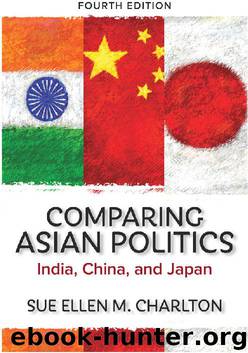Comparing Asian Politics: India, China, and Japan by Sue Ellen M. Charlton

Author:Sue Ellen M. Charlton [Charlton, Sue Ellen M.]
Language: eng
Format: epub
ISBN: 9780813348834
Publisher: Taylor and Francis
Published: 2018-02-07T08:00:00+00:00
9: The Parliamentary System in India and Japan
Introduction: Structuring Power at the National Level
There are multiple ways to structure national power in both democratic and authoritarian states. Power may be deliberately fragmented with checks and balances, as in the American presidential system. The president is simultaneously head of state and head of government and has considerable authority, but that authority must be shared with a strong legislature (Congress) and judiciary. Presidential systems in Asia, such as those found in South Korea, Taiwan, Indonesia, or the Philippines, illustrate the variations in how real power is diffused or concentrated, depending on historical context and political dynamics (Focus Box 9).
FOCUS BOX 9: Presidential Systems in Asia
Presidential systems come in various forms. As a general guideline, we assume that a presidential system—as opposed to the existence of a president in a parliamentary structure such as India’s—implies the separation of powers among the executive, legislative, and judicial branches of government. In this structure, the president, as head of the executive branch, serves as both head of state and head of government, in contrast to a parliamentary system where these roles are divided. In its clearest form, the chief executive is directly elected by the voters. However, there may be alternative arrangements for electing the chief executive, such as funneling the popular vote through an electoral college (as is found in the United States).
In addition, there are quasi-presidential systems, in which the president has considerable power and may even be directly elected but there is also a prime minister who serves some of the same functions as the prime minister (continues) in a parliamentary system. The best-known case of this arrangement is France under the Fifth Republic, where the president is directly elected by the voters. The president then appoints a prime minister who must secure the support of parliament.
Asia illustrates these variations on presidential systems. For example, the Philippines resembles the United States. The president is both head of state and government, as well as serving as commander in chief. She or he, along with a vice president, is directly elected by the voters for a six-year term and has the authority to make cabinet appointments. Indonesian presidents are also directly elected and may serve two five-year terms.
South Korea, Taiwan, Sri Lanka, and Pakistan are all mixed systems, with both a president and a prime minister or premier. But the allocation of powers and responsibilities varies among these nations. For example, the South Korean president is elected for a term of five years by direct popular vote and chooses a prime minister. Cabinet members are appointed by the president on the advice of the prime minister and with the approval of the country’s unicameral legislature. In Taiwan, the president is directly elected to a four-year term, with a two-term limit; he selects a premier, who does not need the confidence of the legislature. The premier heads the Executive Yuan, or cabinet. The president is generally more powerful than the premier in this system, although because
Download
This site does not store any files on its server. We only index and link to content provided by other sites. Please contact the content providers to delete copyright contents if any and email us, we'll remove relevant links or contents immediately.
| Arms Control | Diplomacy |
| Security | Trades & Tariffs |
| Treaties | African |
| Asian | Australian & Oceanian |
| Canadian | Caribbean & Latin American |
| European | Middle Eastern |
| Russian & Former Soviet Union |
The Secret History by Donna Tartt(18797)
The Social Justice Warrior Handbook by Lisa De Pasquale(12117)
Thirteen Reasons Why by Jay Asher(8762)
This Is How You Lose Her by Junot Diaz(6745)
Weapons of Math Destruction by Cathy O'Neil(6110)
Zero to One by Peter Thiel(5657)
Beartown by Fredrik Backman(5571)
The Myth of the Strong Leader by Archie Brown(5395)
The Fire Next Time by James Baldwin(5220)
How Democracies Die by Steven Levitsky & Daniel Ziblatt(5107)
Promise Me, Dad by Joe Biden(5067)
Stone's Rules by Roger Stone(5007)
A Higher Loyalty: Truth, Lies, and Leadership by James Comey(4819)
100 Deadly Skills by Clint Emerson(4818)
Rise and Kill First by Ronen Bergman(4676)
Secrecy World by Jake Bernstein(4615)
The David Icke Guide to the Global Conspiracy (and how to end it) by David Icke(4595)
The Farm by Tom Rob Smith(4415)
The Doomsday Machine by Daniel Ellsberg(4390)
